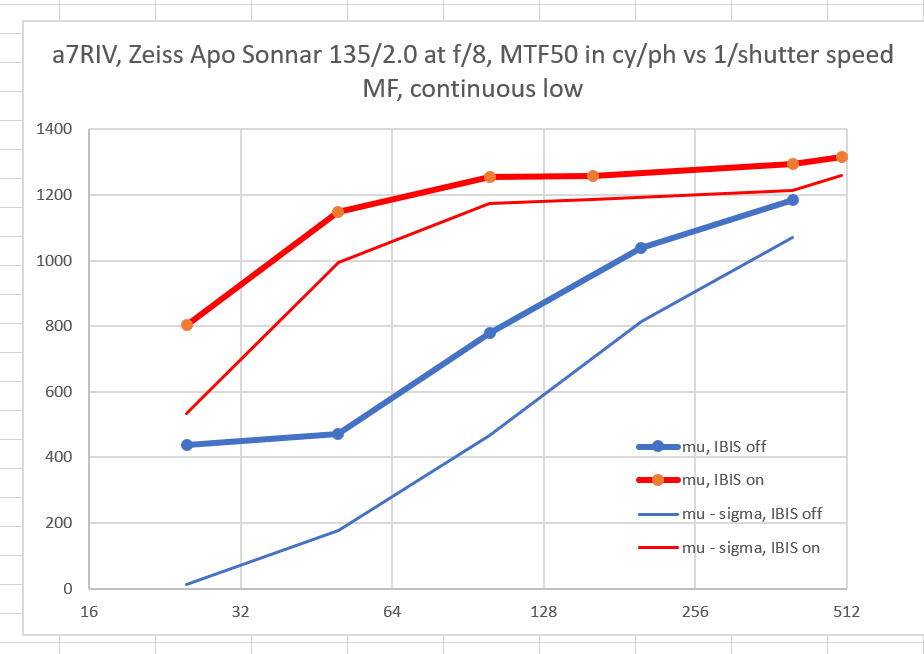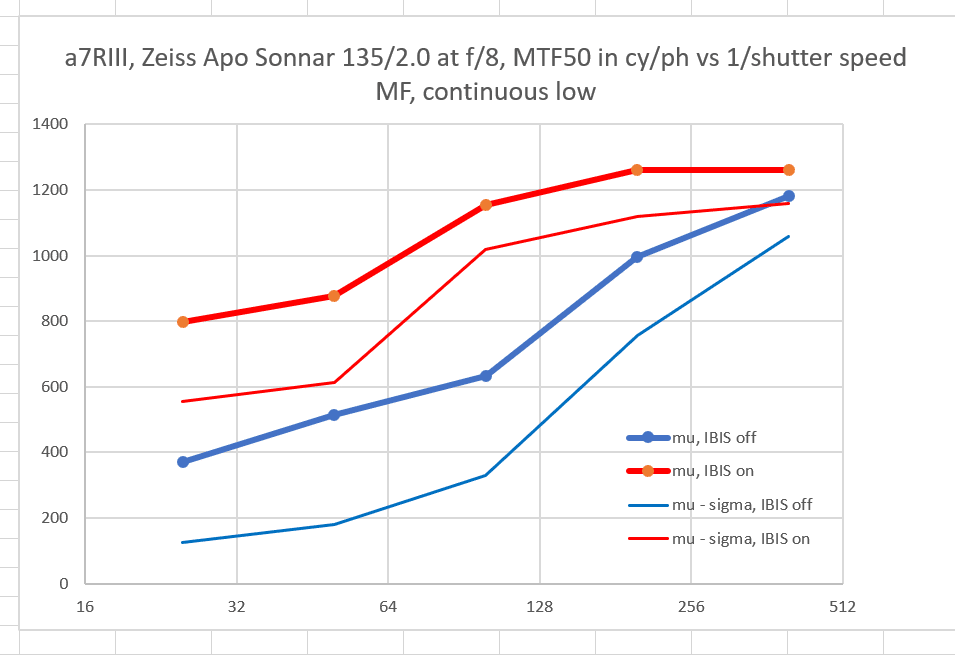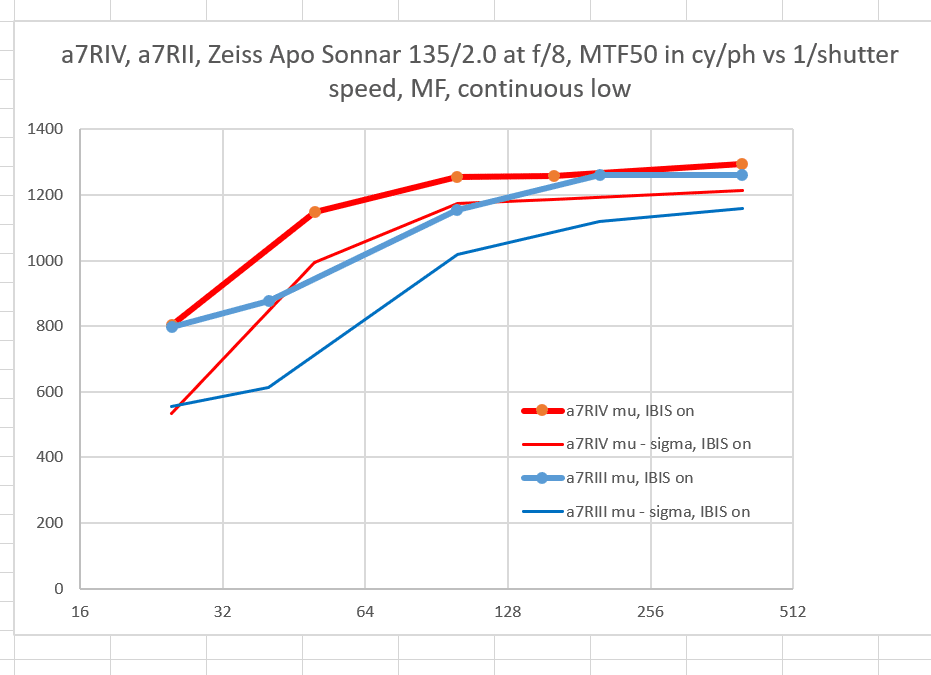This is one in a series of posts on the Sony alpha 7 R Mark IV (aka a7RIV). You should be able to find all the posts about that camera in the Category List on the right sidebar, below the Articles widget. There’s a drop-down menu there that you can use to get to all the posts in this series; just look for “A7RIV”.
In this post, I did a comparison of the Sony a7RIII and a7RIV IBS performance using the Zeiss Batis 135 mm f/2.8 lens. There was some interest in how the two cameras did with a lens that didn’t have built-in optical stabilization.
I though about that. And then, knowing what a royal pain it was to align all the shots, I thought again. After a few days of approach/avoidance, yesterday I bit the bullet and wrote code to automatically align all the shots, and then I spent another couple of hours getting it to run fairly fast. This morning I ran a test using the Zeiss 135 mm f/2 Apo-Sonnar (in Nikon F mount). I couldn’t use autofocus this time, because the lens doesn’t support it. So I focused wide open and made all the exposures at f/8. This is by no means a recipe for sharpness, but it does a good job of assuring that focus differences don’t pollute the results.
Because the lens has a wide focusing ring, I couldn’t use my usual fingers-under-the-lens stabilization technique, so I was less steady than I usually am. Take that into account when you look at the absolute shutter speeds. Marginal steadiness and a focal length of 135 mm is a real test of the camera’s ability to deal with large sensor excursions.
I used the following test conditions:
- Manual focusing at f/2 for first image with each camera
- Continuous low drive mode
- EFCS
- Uncompressed Raw
- ISO 400
- f/8
- Exposure mode A
- Aputure 120d II LED, 12-inch parabolic reflector, remotely controlled
With each camera, with IBIS off, I turned the light up all the way, which gave me a shutter speed of 1/400 second. I made 25 continuous-drive exposures, turned the light down about a stop, and did it again. I kept on doing that until the shutter speed seemed silly, then turned IBIS on and ran the series again.
I ended up with about 600 images. I developed them in Lightroom, with default settings except for the following:
- White balance set to flash
- Sharpening turned off
- Noise reduction turned off
Using my new automatic registration program, I adjusted the cropping in Lightroom for each image so that they were centered. I computed the MTF50 — a nice proxy for sharpness — for all the images with Imatest. Imatest spit out the data in cycles per pixel. I converted that to cycles per picture height to put both cameras on more of an even footing.
I crunched the data in Excel. Here’s what I got for the a7RIV:
The vertical axis is the MTF 50 in cycles per picture height. The horizontal axis is the denominator of the shutter speed — 1/100 second is plotted as 100. The heavy lines are the mean (aka mu, aka average) values. The thinner lines are the mean minus the standard deviation (aka sigma). Because of the way I had to hold the camera, even 1/400 second isn’t fast enough without IBIS. 1/400 second with IBIS off is, on average, about the same as 1/50 second with it on. I know some of you are fond of thinking about IBIS improvement in stops; the span from 1/400 to 1/50 is 3 stops.
Here are the a7RIII results:
The improvement is less.
Here are the IBIS-on results for both cameras:
At 1/50 second, the a7RIV IBIS on mean is pretty darned good. Not so much with the a7RIII. This differences are significant, but not striking. But the sigma for the a7RIII at 1/50 is higher.



Hey Jim,
Please may you test low light focus performace (compared to the A7RIII / A9). I’ve not seen anyone test low light focus performance on the A7RIV yet.
I am finding that in very low ambient using the IV in AF-C results in a noticable delay in acquisition/focus lock. For example it will rack to focus, then there is a further pause until the focus point turns green – even on a static high contrast item. If I switch to Single shot focus lock speed is much better, but of course its not having to continously focus then.
I appreciate that every focus system will suffer in low light, but from memory, I feel like my A7R3 was quicker in low light with AF-C, and slower in Single Shot AF.
I understood that Sony had improved low light AF rating, claiming focus down to -3 EV from -2 EV on the A7R3 .
For my tests I’ve typically been in the ambient exposure range of ISO 10,000 / F1.8 / 60 , and used the 135 GM which is a very fast focussing lens .
Thanks.
Hi,
What’s your opinion that this test’s best MTF has 400 cy/ph behind in comparing to your test with BATIS 135mm that with OSS/IBIS (1600 vs 1200)? Will you be interested in testing it with better lighting condition so that a maximized SS can be found without OSS/IBIS?
Thanks.
The key thing to running this test at a wider f-stop would be getting the target further away. I’d have to go outside for that, but it’s not impossible. I’d have to control the light with an ND filter, since I don’t have a remote that can control the sun.